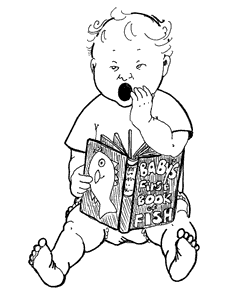STRANGE BUT TRUE- Picture this: Keep turning pages for baby

DRAWING BY DEBORAH DERR McCLINTOCK
Q. Your little bright-eyed bundle of wonders just may be a budding Einstein if Baby... a) had a high birth weight b) has an exceptionally long third toe c) sits up alone at an early age d) at just a few months looks long at a new picture e) at just a few months grows quickly bored by a new picture. –B. Spock
A. Few stones have been left unturned in the search for indicators of infants' later intelligence, but a, b and c have not proved useful, says David Myers in Psychology. Yet studies by Joseph Fagan reveal that 2- to 7- month-old babies who quickly lose interest in a picture, preferring to look at a new one, score higher on tests of brain speed and intelligence up to 11 years later!
Parents can relax here, though, because tests before age three have only minimal validity except for extremely impaired or precocious children. For example, children who are early talkers– at age 20 months using sentences typical of 3-year-olds– are not especially likely to be reading by age 4 1/2. (In fact, "even Albert Einstein was slow in learning to talk.") A better predictor of early reading is having parents who read lots of stories to the child.
Q. You won't see football players out on the field lying on a bed of nails, but the principle that permits this old stunt is applied again and again all game long. Can you nail this one down? –V. Lombardi
A. "Distribution of force," says Timothy Gay in Football Physics: The Science of the Game. He demos this to classes using a bed-sized 3/4-inch-thick piece of plywood with several thousand uppointing 5-inch nails, spaced about an inch apart. "It looks positively medieval... I lie down
on the thing and keep lecturing, making my point." If Gay were to put all his weight on one nail or two or three... yow! But at 500-1000 nails, the pressure on each is so small it won't puncture the skin.
That same distribution of force is how football helmets do their job; plus inside padding, by increasing collision time, reduces the average force to the head. Some years ago, someone got the idea of putting padding on the outside of the helmet; big foam "crowns" came briefly into use, "making players look a bit like space aliens," says Gay.
But injuries actually increased, due to foam pad friction grabbing onto face masks or helmets and torquing the neck.
A better idea is to wax helmets, as is often done, to encourage more glancing blows. Another bed-of-nails device is the hard plastic mouth guard. "A blow to a player's mouth will now act on all teeth at once, minimizing possible dental damage."
So: May the football force be with the players– just not all concentrated at the same point.
Q. A poisonous snake as a national symbol? You gotta be kidding! –Adam
A. The coiled and ready-to-strike rattlesnake appeared on U. S. colonial flags, with the motto "Don't Tread On Me," and on the continental navy flag, c. 1775, says biologist Marty Crump in Headless Males Make Great Lovers. To many, the snake represented vigilance, deadly striking power, and ethics– since it warns before striking and won't initiate fights. Yet once engaged, it won't back down. Like other vipers, the rattler has long moveable fangs, which when not in use fold back and lie against the roof of the mouth. So efficient, it is quick to strike, injecting venom deeply and then withdrawing- all in 200 milliseconds (one-fifth second). But contrary to the motto rationale, some species can be cranky and volatile, making their spare fangs–up to six backups– critical because fully functional fangs are often swallowed along with prey. Just pray it's not you in the strike zone.
Q. If dinosaurs didn't go extinct, what did they do? –M. Crichton
A. The big ones certainly disappeared in the global catastrophe of 65 million years ago, but small, evasive dinosaurs left many surviving descendants, "creatures that can be described as warm-blooded reptiles of a raptorial persuasion, although we more often call them birds," says Nigel Calder in The Magic Universe. The idea of barnyard chickens being related to fearsome T. rex may seem a joke, until we remember that the tyrannosaurs ran about on two legs, as birds do, after hatching out of giant chicken-like eggs. And some of the small fast-running dinosaurs seem similar to flightless birds like ostriches.
Archaeopteryx, dated at around 150 million years ago, was crow-sized with wing-like arms and feathers but also had a toothy jaw and reptilian tail, perhaps an early ancestor of birds. Later came Microraptor from 125-130 million years ago, a small dinosaur suitable for evolving into a bird, snug in its feathery jacket and occupying a treetop niche out of reach of larger predators. Marshes, rivers and seas, shunned by the dinosaurs, soon became parts of the avian empire too. "So be grateful at least that today's dinosaurs tread quite gently on your roof."
Send Strangequestions to brothers Bill and Rich at [email protected].
#